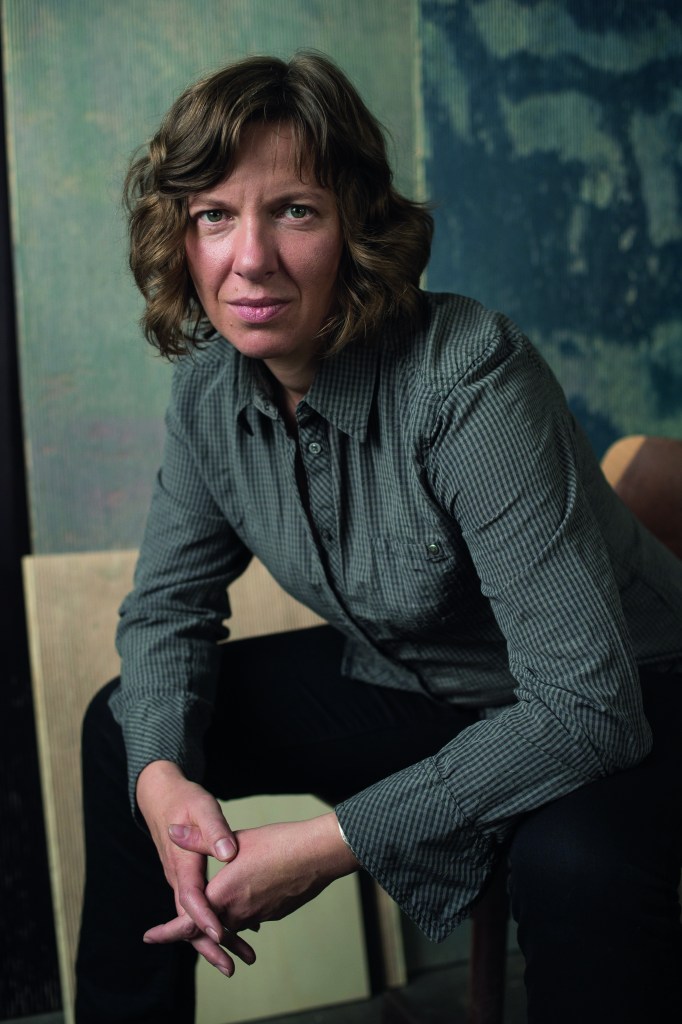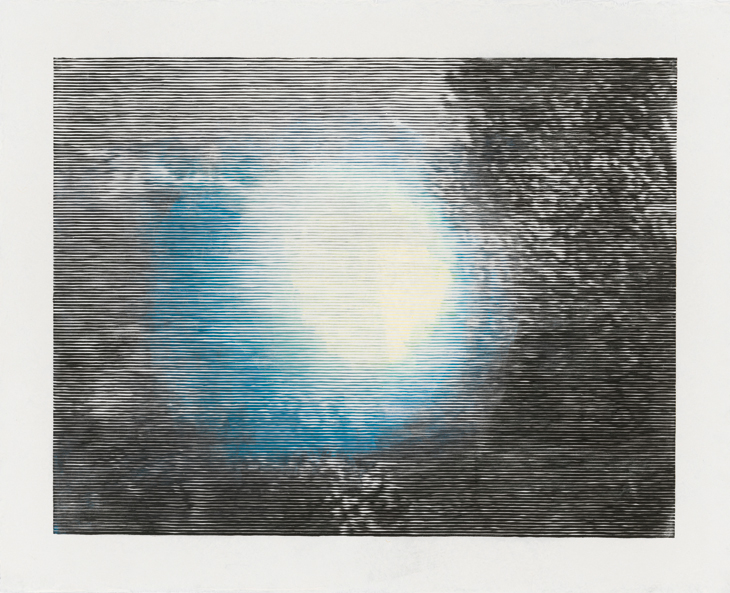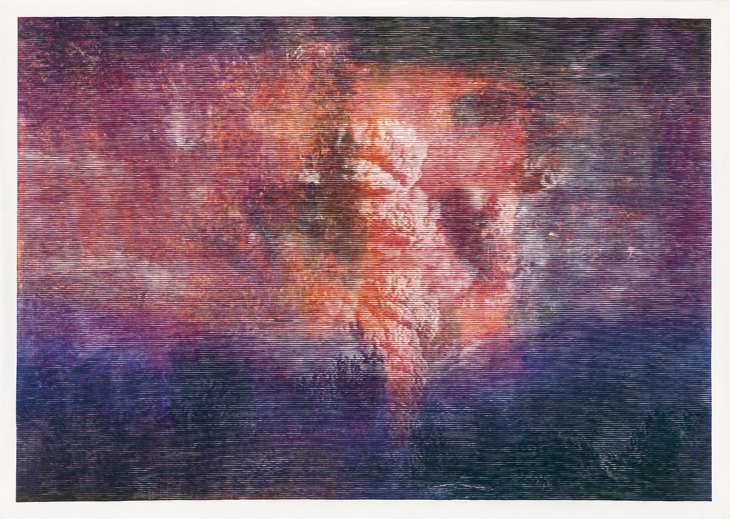The Leipzig-based artist Christiane Baumgartner tells Thomas Marks about her early introduction to woodcut and her more experimental approach to the medium today.
How did you take up the medium of woodcut?
It was a long time ago. I had made woodcuts when I was young, even before
I went to art school in Leipzig. But afterwards, when I studied at the Royal College of Art in London in the 1990s, I didn’t use traditional printmaking at all – then I was working with video and interested in media images, in cool and smooth surfaces, rather than what was handmade.
Earlier in my life I had made artist’s books, using very tactile materials such as handmade paper, but in London I went in the opposite direction, working with just the image. But in a way, the video image is only a formula – it’s not really there – and so in 2000, when I came back to Leipzig, I felt I wanted to do something by hand again. This was the time that the RCA had just got these huge Epson printers, and students were printing inkjet prints and signing them. My impulse was to go back to the analogue, but via the detour of the digital image.
Christiane Baumgartner. Photo: Uwe Frauendorf, Leipzig

How conscious were you of woodcut as a distinctly German medium, given the Renaissance tradition and, in the 20th century, the Expressionist revival?
At the Hochschule für Grafik und Buchkunst in Leipzig, we had this very traditional education, with woodcut courses, etching, and lithography. We had to copy medieval woodcuts, so we really had to learn the technique. But I started to think about woodcut again because I was in England. When you are abroad, you sometimes feel your nationality more strongly than when you’re at home. And when I went back to Germany, I had traditional German woodcuts very much in mind: Albrecht Dürer, and that tradition of the black and white woodcut. That was why I first worked in black and white, not colour.
In a way, the woodcut is the earliest reproduction technique. It has more to
do with image reproduction than with printmaking itself. And it’s such a simple thing: you just need a piece of wood and a sharp knife, then you cut into the wood and ink it up. You don’t even need a press: you can handprint using a spoon.
How did your adoption of woodcut fit in with the Leipzig School painters?
When I came back from London, Leipzig was famous for painting. This was to do with Neo Rauch, and the students he was teaching while he was an assistant to Arno Rink. I always felt a bit connected to this group, because I had come out of the same school, but by working in woodcut I was – not an outsider, because I had my studio where they all were – but their counterpart. Now there are many young artists using printmaking techniques in Leipzig, but at the time it was a bit strange – especially making woodcuts of video stills.
Transall (2002–04), Christiane Baumgartner. Courtesy the artist and Alan Cristea Gallery, London

How do you select the images that become the basis for your woodcuts?
It all started with an image of a highway, from a video I made while I had a residency in Lisbon. For a year, I was interested in the still images of movement, and was thinking about how I could transform them by making something handmade. Woodcut is such a manual technique, and the body is so intensely involved in it, that it really slows you down. For me it was important to deal with high speed and slowness together – later I used images of airplanes, as in Transall [2002–04], and others taken from a moving car. I always thought that I would stop doing woodcut and move on to something else, but it kept generating more ideas: the speed-related images were replaced by images of war from the TV, and then by
low-resolution images.
Weisse Sonne (2016), Christiane Baumgartner. Courtesy the artist and Alan Cristea Gallery, London

How important is the manual act of cutting wood to how you think about your work?
It’s about slowing myself down. I’m forced to spend several hours in my studio a day, just doing this cutting. It’s like meditation: I’m concentrating but open-minded at the same time, and my thoughts can circle around the work. This way, it’s all to do with me: sometimes you have a bad day, or there are broken lines. And when I place a computer print-out of the image next to my woodcut print, the woodcut looks so much more alive. The computer print-out is just a dead image. It’s not there.
Why do you choose to work on such a large scale?
Some images demand a large scale, and I think the airplanes in Transall just had to be big. If the work is large, I can cut the horizontal lines wider, which makes the viewer stand back from it, to see the image. If you step too close to the work, you just see the abstract lines.
How far do the images that you’ve used for your new works, including those of natural phenomena and artificial light, represent a departure for you in terms of subject matter?
I can’t fully define the new work yet: often I need a few years to determine how new works connect to what I’ve made before. But I think I would never have done the sunsets [such as Nordlicht] if I hadn’t worked with the airplanes and war imagery earlier. And because I focused on such clear objects before, I think I am now interested in images of more incorporeal things, such as the colour spot on the retina that’s left after you look at the sun [in Weisse Sonne]. So it’s also about seeing, which is why colour has come into my work.
Phoenix (2018), Christiane Baumgartner. Courtesy the artist and Alan Cristea Gallery, London

My woodcuts have now become more painterly as well. The most recent one, Phoenix, shows a volcano and is printed in five colours. I can’t tell how far away from the graphic arts I will move, but when you work with colour, you have to think about painting. It’s a different wayof thinking and seeing than working with black and white.
As a printmaker, do you feel like an outlier in the world of contemporary art?
I don’t call myself a printmaker. I call myself an artist working in print, or in woodcut. To be honest, one would never ask this question to a sculptor or a video artist, but ‘printmaking’ – especially the word in English – implies so much handiwork. For me, technique is very important, and it takes a lot of time and energy, but it’s not fundamental to how people view the final work.
‘Christiane Baumgartner: Liquid Light’ is at Alan Cristea Gallery, London, until 21 April.
From the April issue of Apollo. Preview and subscribe here.



